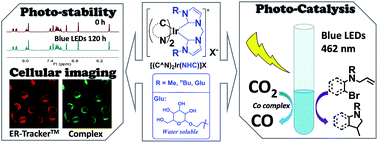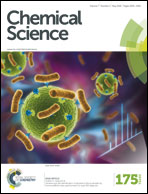Stable luminescent iridium(iii) complexes with bis(N-heterocyclic carbene) ligands: photo-stability, excited state properties, visible-light-driven radical cyclization and CO2 reduction, and cellular imaging†
Abstract
A new class of cyclometalated Ir(III) complexes supported by various bidentate C-deprotonated (C^N) and cis-chelating bis(N-heterocyclic carbene) (bis-NHC) ligands has been synthesized. These complexes display strong emission in deaerated solutions at room temperature with photoluminescence quantum yields up to 89% and emission lifetimes up to 96 μs. A photo-stable complex containing C-deprotonated fluorenyl-substituted C^N shows no significant decomposition even upon irradiation for over 120 h by blue LEDs (12 W). These, together with the strong absorption in the visible region and rich photo-redox properties, allow the bis-NHC Ir(III) complexes to act as good photo-catalysts for reductive C–C bond formation from C(sp3/sp2)–Br bonds cleavage using visible-light irradiation (λ > 440 nm). A water-soluble complex with a glucose-functionalized bis-NHC ligand catalysed a visible-light-driven radical cyclization for the synthesis of pyrrolidine in aqueous media. Also, the bis-NHC Ir(III) complex in combination with a cobalt catalyst can catalyse the visible-light-driven CO2 reduction with excellent turnover numbers (>2400) and selectivity (CO over H2 in gas phase: >95%). Additionally, this series of bis-NHC Ir(III) complexes are found to localize in and stain endoplasmic reticulum (ER) of various cell lines with high selectivity, and exhibit high cytotoxicity towards cancer cells, revealing their potential uses as bioimaging and/or anti-cancer agents.


 Please wait while we load your content...
Please wait while we load your content...